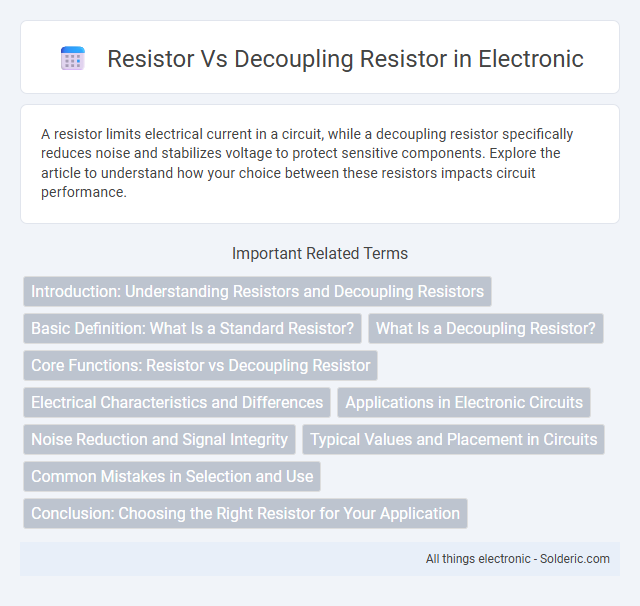A resistor limits electrical current in a circuit, while a decoupling resistor specifically reduces noise and stabilizes voltage to protect sensitive components. Explore the article to understand how your choice between these resistors impacts circuit performance.
Comparison Table
| Feature | Resistor | Decoupling Resistor |
|---|---|---|
| Primary Function | Limit current, divide voltage, and control signal levels | Reduce noise and stabilize voltage by isolating circuits |
| Placement | Anywhere in circuits, commonly in series or parallel | Between power supply and circuit or near IC power pins |
| Typical Resistance Range | Ohms to Megaohms, depending on application | Low to moderate values (e.g., 10O to 100O) |
| Role in Circuit | General passive component for current and voltage control | Noise suppression and prevention of voltage spikes |
| Integration | Standalone or in combination with other components | Used with capacitors in decoupling networks |
Introduction: Understanding Resistors and Decoupling Resistors
Resistors control current flow by providing a defined resistance, essential for managing voltage and protecting circuits. Decoupling resistors specifically reduce noise and signal interference by isolating components, enhancing circuit stability. Your electronic designs benefit from using decoupling resistors to maintain clean power lines and reliable performance.
Basic Definition: What Is a Standard Resistor?
A standard resistor is a passive electronic component designed to limit or regulate the flow of electrical current in a circuit by providing a specific amount of resistance, measured in ohms. It serves fundamental roles such as voltage division, current limiting, and signal conditioning. Unlike a decoupling resistor, which specifically helps reduce noise and stabilize voltage by working alongside decoupling capacitors, a standard resistor is used primarily for controlling current and voltage within various parts of your electronic designs.
What Is a Decoupling Resistor?
A decoupling resistor is used in electronic circuits to reduce noise and prevent unwanted interference by isolating different sections of a circuit. Unlike a standard resistor that primarily limits current or divides voltage, a decoupling resistor is specifically placed in series with the power supply line to stabilize voltage and improve signal integrity. This resistor works in conjunction with decoupling capacitors to filter high-frequency noise and maintain stable operation of sensitive components.
Core Functions: Resistor vs Decoupling Resistor
Resistors regulate current flow and divide voltage in electronic circuits by providing a defined resistance, essential for controlling signal and power levels. Decoupling resistors specifically reduce noise and voltage spikes by isolating components and stabilizing power supply lines in high-frequency applications. Unlike general-purpose resistors, decoupling resistors improve circuit stability and enhance electromagnetic compatibility by minimizing interference.
Electrical Characteristics and Differences
A standard resistor provides a fixed resistance to limit current flow and drop voltage in a circuit, characterized by its resistance value, power rating, and tolerance. A decoupling resistor, often used in high-speed digital circuits, combines resistance with noise reduction by filtering transient signals and isolating components to stabilize voltage supply lines. Unlike typical resistors primarily focused on current control, decoupling resistors play a critical role in minimizing electromagnetic interference (EMI) and improving signal integrity in sensitive electronic systems.
Applications in Electronic Circuits
Resistors serve as fundamental components in electronic circuits, managing current flow and voltage levels across various applications such as biasing transistors, setting operating points, and forming voltage dividers. Decoupling resistors specifically improve signal integrity by isolating noise sources and reducing interference between circuit stages, often used alongside decoupling capacitors in power supply lines. Their strategic placement minimizes voltage spikes and stabilizes voltage supply, enhancing the overall performance and reliability of sensitive analog and digital circuits.
Noise Reduction and Signal Integrity
Resistors primarily control current and voltage levels in circuits, whereas decoupling resistors specifically reduce noise and improve signal integrity by filtering high-frequency interference between power and ground lines. Decoupling resistors work alongside capacitors to stabilize voltage supply and minimize electromagnetic interference, which is critical in sensitive analog and digital circuits. Implementing decoupling resistors effectively enhances overall circuit performance by preventing voltage spikes and preserving signal clarity.
Typical Values and Placement in Circuits
Resistors typically range from 1 ohm to several megaohms and are placed throughout circuits for current limiting, voltage division, and signal conditioning. Decoupling resistors usually have lower values, often between 10 and 100 ohms, and are positioned close to integrated circuits to isolate noise and stabilize power supply lines. Proper placement of decoupling resistors near the IC power pins enhances transient response and reduces electromagnetic interference in sensitive electronic designs.
Common Mistakes in Selection and Use
Selecting the wrong resistance value or type can cause ineffective noise suppression and signal integrity issues in decoupling resistor applications, often leading to circuit instability. Confusing standard resistors with decoupling resistors results in inadequate filtering of high-frequency noise due to improper frequency response characteristics. Using decoupling resistors without considering power rating and tolerance specifications can cause premature failure and inconsistent circuit performance.
Conclusion: Choosing the Right Resistor for Your Application
Selecting the right resistor depends on the specific function within the circuit: standard resistors control current flow and voltage levels, while decoupling resistors are specialized to stabilize power supply lines by minimizing noise and interference. Understanding the electrical requirements, such as resistance value, tolerance, and power rating, ensures optimal performance and reliability. Choose decoupling resistors in high-frequency and sensitive analog or digital circuits, while standard resistors suit general current-limiting or voltage-dividing applications.
resistor vs decoupling resistor Infographic

 solderic.com
solderic.com